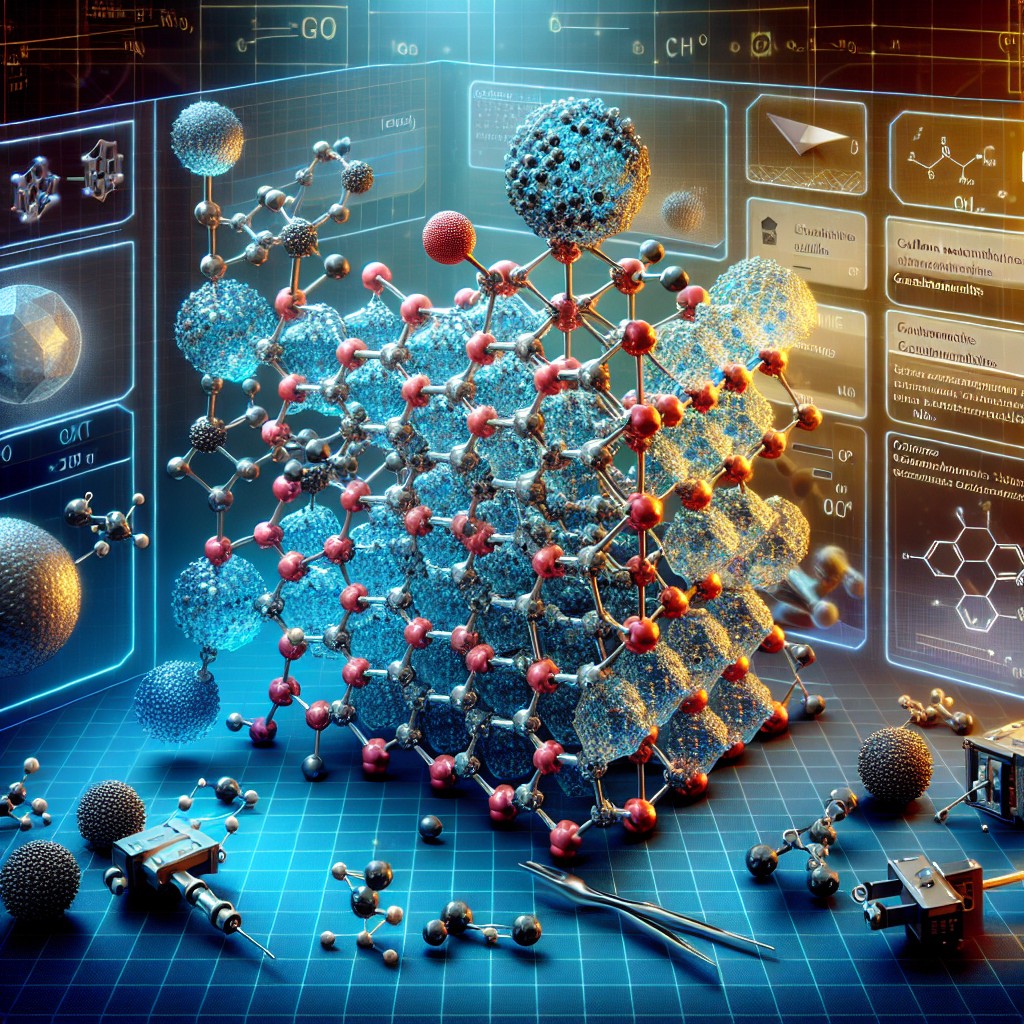Materials chemistry is a branch of chemistry that focuses on the study of the properties, synthesis, and structure of materials. It involves understanding the building blocks of matter and how they can be manipulated to create new materials with desired properties. This field plays a crucial role in various industries, including medicine, electronics, energy, and construction. By understanding the chemistry behind materials, scientists and engineers can develop innovative solutions to real-world problems.
Understanding the building blocks of matter is essential because it allows scientists to design and create materials with specific properties. For example, by understanding the chemical composition and structure of a material, researchers can determine its strength, conductivity, or reactivity. This knowledge is then used to develop new materials that can be used in a wide range of applications. Without a deep understanding of materials chemistry, it would be challenging to create new materials with improved properties or develop more efficient manufacturing processes.
Summary
- Materials chemistry is the study of the building blocks of matter.
- Polymers play a crucial role in materials chemistry, from plastics to biodegradable materials.
- Nanomaterials are the future of materials chemistry, with potential applications in medicine and electronics.
- Metals, ceramics, glass, composites, and adhesives all have unique properties that make them useful in a variety of applications.
- Materials chemistry is essential for sustainable development and will continue to drive innovation in the future.
The Role of Polymers in Materials Chemistry
Polymers are large molecules made up of repeating subunits called monomers. They are versatile materials that have a wide range of applications in modern society. Plastics, for example, are polymer-based materials that are used in packaging, construction, and electronics. They are lightweight, durable, and can be molded into various shapes. Biodegradable polymers are another example of polymer-based materials that are gaining popularity due to their environmentally friendly nature.
Polymers play a crucial role in modern society because they offer unique properties that other materials do not possess. For example, they can be flexible or rigid depending on their chemical composition and structure. This flexibility allows them to be used in a wide range of applications. Additionally, polymers can be designed to have specific properties such as high strength or conductivity. This versatility makes them ideal for use in industries such as automotive, aerospace, and healthcare.
Nanomaterials: The Future of Materials Chemistry
Nanomaterials are materials that have unique properties at the nanoscale, which is the scale of atoms and molecules. They are typically made up of nanoparticles, which are particles with dimensions between 1 and 100 nanometers. Nanomaterials have a wide range of applications in various fields, including medicine, electronics, and energy.
In medicine, nanomaterials are used for drug delivery, imaging, and tissue engineering. They can be designed to target specific cells or tissues, allowing for more precise and effective treatments. In electronics, nanomaterials are used to create smaller and more efficient devices. For example, nanowires made from materials such as silicon or carbon can be used to create transistors that are faster and consume less power. In the energy sector, nanomaterials are being explored for use in solar cells, batteries, and fuel cells. They have the potential to improve the efficiency and performance of these devices.
While nanomaterials offer many potential benefits, there are also risks associated with their use. Due to their small size, nanoparticles can easily enter the body through inhalation or ingestion. This raises concerns about their potential toxicity. Additionally, the environmental impact of nanomaterials is still not fully understood. It is essential for scientists and policymakers to carefully consider the potential risks and benefits of nanomaterials to ensure their safe and responsible use.
The Chemistry of Metals
| Element | Symbol | Atomic Number | Atomic Mass | Melting Point (°C) | Boiling Point (°C) |
|---|---|---|---|---|---|
| Iron | Fe | 26 | 55.845 | 1538 | 2862 |
| Copper | Cu | 29 | 63.546 | 1084 | 2562 |
| Gold | Au | 79 | 196.967 | 1064 | 2856 |
| Silver | Ag | 47 | 107.868 | 961.8 | 2162 |
Metals are a class of materials that have high electrical conductivity and thermal conductivity. They are typically shiny, malleable, and ductile. Examples of metal-based materials include steel, aluminum, copper, and titanium. Metals have a wide range of applications in various industries due to their unique properties.
One of the most common uses of metals is in construction. Steel, for example, is used in the construction of buildings, bridges, and infrastructure due to its high strength and durability. Aluminum is another metal that is widely used in construction due to its lightweight nature. In the automotive industry, metals such as steel and aluminum are used to make car bodies and engine components. Metals are also used in electronics, where their high electrical conductivity makes them ideal for wiring and circuitry.
The Properties of Ceramics
Ceramics are materials that are typically made from inorganic compounds such as clay, silica, or alumina. They have unique properties that make them suitable for a wide range of applications. Examples of ceramic-based materials include pottery, bricks, and high-tech applications such as ceramic coatings and superconductors.
One of the key properties of ceramics is their high strength and hardness. This makes them ideal for use in applications where durability is essential, such as in the construction of buildings or the manufacturing of cutting tools. Ceramics also have excellent thermal and electrical insulation properties, which make them suitable for use in high-temperature environments or as electrical insulators. Additionally, ceramics can be designed to have specific optical properties, making them useful in applications such as optics and lasers.
The Chemistry of Glass

Glass is a unique material that is neither a solid nor a liquid. It is an amorphous solid that is made by cooling a molten material such as silica or borosilicate. The science behind glass formation is complex and still not fully understood. However, it is known that the rapid cooling of a molten material prevents the atoms from arranging themselves into a crystalline structure, resulting in an amorphous solid.
Glass has a wide range of applications in various industries. In the construction industry, glass is used for windows, doors, and facades due to its transparency and ability to let light through. In the electronics industry, glass is used for display screens and optical fibers due to its excellent optical properties. Glass is also used in the manufacturing of laboratory equipment, such as test tubes and beakers, due to its chemical inertness.
The Chemistry of Composites
Composites are materials that are made by combining two or more different materials to create a new material with improved properties. The individual materials, called the matrix and the reinforcement, work together to create a material that is stronger, lighter, or more durable than the individual components. Examples of composite-based materials include carbon fiber, fiberglass, and reinforced concrete.
One of the advantages of composites over traditional materials is their high strength-to-weight ratio. For example, carbon fiber composites are much lighter than steel but have similar or even higher strength. This makes them ideal for use in applications where weight reduction is critical, such as in the aerospace industry. Composites also have excellent resistance to corrosion and fatigue, making them suitable for use in harsh environments.
The Chemistry of Adhesives
Adhesives are substances that are used to bond two or more materials together. They can be natural or synthetic and come in various forms such as liquids, pastes, or tapes. Examples of adhesive-based materials include super glue, epoxy resins, and structural adhesives used in aerospace applications.
Adhesives play a crucial role in modern manufacturing because they offer several advantages over traditional joining methods such as welding or mechanical fastening. For example, adhesives can distribute stress more evenly across a joint, resulting in a stronger bond. They can also join dissimilar materials together, such as metal and plastic. Additionally, adhesives can provide sealing and insulation properties, making them useful in applications where airtightness or electrical insulation is required.
The Role of Materials Chemistry in Sustainable Development
Sustainable development is a concept that aims to meet the needs of the present generation without compromising the ability of future generations to meet their own needs. Materials chemistry plays a crucial role in achieving sustainable development by developing innovative materials and processes that reduce environmental impact and promote resource efficiency.
One example of materials chemistry innovation for sustainability is the development of recycling technologies. By understanding the chemistry of materials, scientists can develop processes to recycle and reuse materials such as plastics, metals, and glass. This reduces the need for virgin materials and reduces waste generation. Another example is the development of materials for renewable energy applications. Materials chemistry is essential in developing more efficient solar cells, batteries, and fuel cells that can help reduce reliance on fossil fuels.
The Future of Materials Chemistry
The future of materials chemistry holds great promise for advancements and breakthroughs in various fields. With continued research and development, scientists and engineers can create new materials with improved properties and develop more sustainable manufacturing processes.
One area of research that holds great potential is the development of smart materials. These are materials that can respond to external stimuli such as temperature, light, or pressure. For example, smart materials could be used to create self-healing coatings that can repair themselves when damaged or shape-memory alloys that can change shape when exposed to heat.
Another area of research is the development of biomaterials for medical applications. Biomaterials are materials that are compatible with living tissues and can be used to replace or repair damaged tissues or organs. By understanding the chemistry of biomaterials, scientists can develop new materials that can improve patient outcomes and quality of life.
In conclusion, materials chemistry plays a crucial role in understanding the building blocks of matter and developing new materials with desired properties. Polymers, nanomaterials, metals, ceramics, glass, composites, and adhesives are all examples of materials that have unique properties and applications. Materials chemistry also plays a vital role in achieving sustainable development by developing innovative materials and processes that reduce environmental impact. The future of materials chemistry holds great promise for advancements and breakthroughs in various fields, but continued research and development are essential to unlock its full potential.
FAQs
What is Materials Chemistry?
Materials Chemistry is a branch of chemistry that deals with the study of the properties, synthesis, and design of materials. It involves the investigation of the relationship between the structure and properties of materials.
What are the applications of Materials Chemistry?
Materials Chemistry has a wide range of applications in various fields such as electronics, energy, medicine, and environmental science. It is used in the development of new materials for energy storage, drug delivery, and environmental remediation.
What are the types of materials studied in Materials Chemistry?
Materials Chemistry covers a wide range of materials including metals, ceramics, polymers, composites, and nanomaterials. These materials have different properties and applications, and their study is essential for the development of new materials with improved properties.
What are the techniques used in Materials Chemistry?
Materials Chemistry uses a variety of techniques such as spectroscopy, microscopy, X-ray diffraction, and computational methods. These techniques are used to study the structure, properties, and behaviour of materials at the atomic and molecular level.
What are the challenges in Materials Chemistry?
Materials Chemistry faces several challenges such as the development of sustainable materials, the design of materials with specific properties, and the understanding of the relationship between the structure and properties of materials. These challenges require interdisciplinary approaches and collaborations between scientists from different fields.


